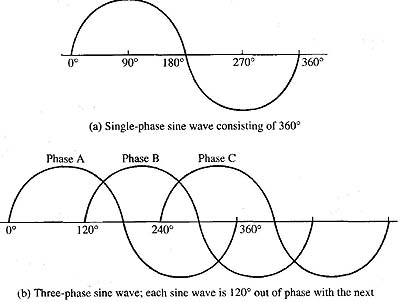AMAZON multi-meters discounts AMAZON oscilloscope discounts
The three-phase AC motor is an induction motor. It's designed specifically to take advantage of the characteristics of the three-phase voltage that it uses for power. Fig. 1 (below) shows a diagram of three-phase voltage. From this diagram notice that each of the three phases represents a separately generated voltage. Recall that the three-phase generator has three separate windings that produce the three voltages slightly out of phase with each other. The units of measure for this voltage are electrical degrees. An electrical degree represents one sine wave in 360 degrees. The sine wave may be produced once during each rotation of the generator’s shaft or twice during each generator's shaft rotation. If the sine wave is produced by one rotation of the generator’s shaft, 360 electrical degrees are equal to 360 mechanical degrees. If the sine wave is produced twice during each shaft’s rotation, 360 electrical degrees are equal to 180 mechanical degrees. Since this can tend to be confusing, all electrical diagrams are presented in terms of 360 electrical degrees being equal to 360 mechanical degrees. In this way the degrees will be the same and one won't have to try and figure out if electrical or mechanical degrees are being used in the example.

Above: Fig. 1: Diagram of three-phase voltage. Notice the phase
shift between each voltage sine wave is 120°.
The first voltage shown in the diagram is called A phase and it's shown starting at 0° and peaking positively at the 90° mark. It passes through 0 volts again at the 180° mark and peaks negatively at the 270° mark. After it peaks negatively, it returns to 0 volts at the 360° mark, which is also the 0° point. The second voltage is called B phase and starts its zero-voltage point 120° later than A phase. B phase peaks positively, passes through zero voltage, and passes through negative peak voltage as A phase does, except that it's always 1200 later than A phase. That is, B phase is increasing in the positive direction when A phase is passing through its zero voltage at the 180° mark. The third voltage shown on this diagram is called C phase. It starts at its zero- voltage point 240° after A phase starts at its zero-voltage point. This puts B phase 120° out of phase with A phase and C phase 120° out of phase with B phase.
The ac motor takes advantage of this characteristic to provide a rotating magnetic field in its stator and rotor that is very strong because three separate fields rotate 120° out of phase with each other. Since the magnetic fields are induced from the applied voltage, they will always be 120° out of phase with each other. Don't worry about the induced magnetic field being 180° out of phase with the voltage that induced it. At this time this phase difference is not as important as the 120° phase difference between the rotating magnetic fields. Since the magnetic fields are 120° out of phase with each other and are rotating, one will always be increasing its strength when one of the other phases is losing its strength by passing through the zero-voltage point on its sine wave. That is, the magnetic field produced by all three phases never fully collapses and its average is much stronger than that of a field produced by single-phase voltage.
Suggested reading: Basic Polyphase Devices